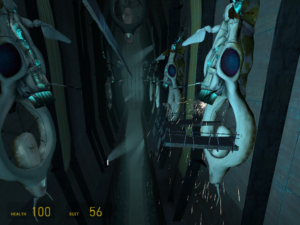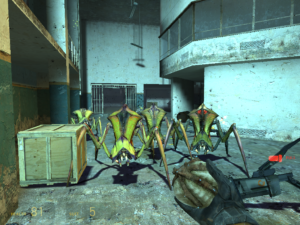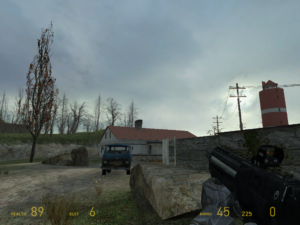Cyberia: Aerial Combat
So, my latest session was all about the Rebel Assault-style FMV swoop-and-shoot. For a lengthy portion of the game, that’s all you get, just one air-combat mission after another. It makes me think of how the vehicle sections of Half-Life 2 were broken up with obstacles that you could only clear by getting out the the vehicle and pressing a switch or something in a guarded building nearby, a fragment of ordinary FPS gameplay inserted to make the whole thing less monotonous. Nothing of that kind happens here.
I have a couple more big complaints about the way air combat is handled here. One is that the underlying movie clip sometimes cuts away to show a third-person shot of a particularly dramatic explosion or your plane noninteractively executing a sweet maneuver, and that’s pretty much always a mistake in the middle of an action scene, particularly if there are still targets on the screen that the mini-cutscene is keeping the player from blowing up. Even worse, because some of these cutscenes show things that you can shoot at blowing up, there is no way to destroy those things before the video playback reaches the cutscene. You’ll be shooting at a plane over and over for a couple of seconds with no effect, and that’s frustrating.
Also, I can’t help but feel that this sort of fast-paced first-person air combat really needs a resolution higher than 320×200. Enemies often spend most of their time onscreen as one or two pixels, too small to identify even on the level of “is it a plane or a tank”, and thus too small for the player to anticipate their behavior or prioritize their destruction. Instead, we’re given the opportunity to learn what’s going to happen and how to react to it by means of exact repetition.
To be honest, there is a pleasure to be found in this: the pleasure of finally overcoming a challenge that you’ve failed many times, a mix of triumph and relief. But I’m impatient with this game, and want it off my Stack, and some of the levels just seem insanely difficult. And so I’ve dropped the difficulty down to Easy for action sequences (the game has separate difficulty settings for action and puzzles), despite the implication in the docs that this setting is for babies and grandmothers. Even on Easy, I had some difficulty with the later shooty levels, but the overall experience was an improvement, replacing the pleasure of overcoming a challenge failed repeatedly with that of getting it right on the first try.
There was just one problem: the game doesn’t support switching difficulty settings on the fly. To drop down to Easy, you have to create a new profile and start over from the beginning. But I didn’t have a whole lot of ground to re-cover, and it goes a lot faster when you know what you’re doing. Also, I decided to take advantage of this discontinuity by switching to a different machine, and found that on the other one I could play full-screen without problems. I’m finding this much nicer, even if it does expose the pixelation more. Well, it’s not like the graphics were all that good anyway, right?
Anyway, I seem to be done with this stuff, at least for now. Last night, after something resembling a boss fight (involving a large aircraft with three weapons that had to be destroyed individually), I reached my destination, the compound housing the Cyberia project (which is something to do with nanotechnology), and that seemed like a good stopping-point for the session. It remains to be seen if I’ll need to do more dogfighting as I make my escape.
 Comments(0)
Comments(0)

